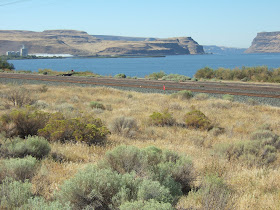A story that got a bit of national media attention on the age of the Grand Canyon caused a number of folks to ask me about what I thought of the old versus young debate on the age of the Grand Canyon. Well I know almost nothing. Wayne Ranney who does know something provides a nice understandable summary/overview as well as a worthwhile take on scientific "controversy" latest-big-controversy-age-grand-canyon.
Controversy happens and interpretations of established facts can lead to different conclusions. While there are established facts not all facts are known and new facts can leading to different interpreations and conclusions. The tricky part of interpretation is presenting the facts and assumptions.
But in regards to the young versus old river what I find interesting is the whole concept of the history of a river. Rivers and streams shape our landscape. But likewise the geology of an area shapes rivers and streams. A few associates and I have had lengthily discussions about a few of our local northwest Washington rivers and just what the history of those rivers have been over the just the past 13,000 years. It is remarkably tricky and what initially seems a simple easily resolved problem turns out to be not so simple with multiple viable alternatives. Our discussions have yet to make the news cycle or reach any definitive conclusions.
On another river history in Washington State, I've been doing some reading on Wallula Gap. Wallula Gap is the place where the Columbia River passes through the Horse Heaven Hills. The gap is a remarkable canyon with shear basalt cliffs towering above the Columbia River on both sides of the gap.
During the great ice age floods, Wallula Gap greatly slowed the flood waters backing up short lived lakes that resulted in the now rich farm land in the Yakima Valley and the Walla Walla Valley.
One might assume that Wallula Gap was carved by the Columbia River as the Horse Heaven Hills were uplifted. But that assumption is incorrect. The Columbia formerly passed through the Horse Heaven Hills 60 or so miles to the west. The gap was initially occupied another river. One might then assume it was the mighty Snake River, the biggest tributary to the Columbia. But again that assumption is not right. The gap initiualy occupied by the Clearwater River, a tributary of the Snake. Where was the Snake River at that time? Somewhere to the south, Who knows where? How did the Snake end up where it is today? What exactly caused the Columbia to shift to its present location at Wallula Gap? See nwgs.org/field_trip_guides/Evolution_of_the_Columbia_River.pdf for a nice summary of the state of understanding with a series of maps starting on page 32.
Given how far inland and how old the rocks are at the Grand Canyon, I'm guessing it is complicated with every new bit of information adding to the puzzle.
Controversy happens and interpretations of established facts can lead to different conclusions. While there are established facts not all facts are known and new facts can leading to different interpreations and conclusions. The tricky part of interpretation is presenting the facts and assumptions.
But in regards to the young versus old river what I find interesting is the whole concept of the history of a river. Rivers and streams shape our landscape. But likewise the geology of an area shapes rivers and streams. A few associates and I have had lengthily discussions about a few of our local northwest Washington rivers and just what the history of those rivers have been over the just the past 13,000 years. It is remarkably tricky and what initially seems a simple easily resolved problem turns out to be not so simple with multiple viable alternatives. Our discussions have yet to make the news cycle or reach any definitive conclusions.
On another river history in Washington State, I've been doing some reading on Wallula Gap. Wallula Gap is the place where the Columbia River passes through the Horse Heaven Hills. The gap is a remarkable canyon with shear basalt cliffs towering above the Columbia River on both sides of the gap.
1,500-foot cliff at Wallula Gap
Wallula Gap from near the site of Old Fort Walla Walla
During the great ice age floods, Wallula Gap greatly slowed the flood waters backing up short lived lakes that resulted in the now rich farm land in the Yakima Valley and the Walla Walla Valley.
One might assume that Wallula Gap was carved by the Columbia River as the Horse Heaven Hills were uplifted. But that assumption is incorrect. The Columbia formerly passed through the Horse Heaven Hills 60 or so miles to the west. The gap was initially occupied another river. One might then assume it was the mighty Snake River, the biggest tributary to the Columbia. But again that assumption is not right. The gap initiualy occupied by the Clearwater River, a tributary of the Snake. Where was the Snake River at that time? Somewhere to the south, Who knows where? How did the Snake end up where it is today? What exactly caused the Columbia to shift to its present location at Wallula Gap? See nwgs.org/field_trip_guides/Evolution_of_the_Columbia_River.pdf for a nice summary of the state of understanding with a series of maps starting on page 32.
Given how far inland and how old the rocks are at the Grand Canyon, I'm guessing it is complicated with every new bit of information adding to the puzzle.


No comments:
Post a Comment